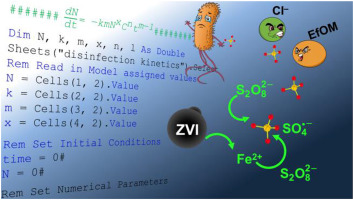当前位置:
X-MOL 学术
›
Water Res.
›
论文详情
Our official English website, www.x-mol.net, welcomes your feedback! (Note: you will need to create a separate account there.)
Elucidating sulfate radical-mediated disinfection profiles and mechanisms of Escherichia coli and Enterococcus faecalis in municipal wastewater.
Water Research ( IF 12.8 ) Pub Date : 2020-01-28 , DOI: 10.1016/j.watres.2020.115552 Ruiyang Xiao 1 , Lu Bai 1 , Kai Liu 1 , Yan Shi 1 , Daisuke Minakata 2 , Ching-Hua Huang 3 , Richard Spinney 4 , Rajesh Seth 5 , Dionysios D Dionysiou 6 , Zongsu Wei 7 , Peizhe Sun 8
Water Research ( IF 12.8 ) Pub Date : 2020-01-28 , DOI: 10.1016/j.watres.2020.115552 Ruiyang Xiao 1 , Lu Bai 1 , Kai Liu 1 , Yan Shi 1 , Daisuke Minakata 2 , Ching-Hua Huang 3 , Richard Spinney 4 , Rajesh Seth 5 , Dionysios D Dionysiou 6 , Zongsu Wei 7 , Peizhe Sun 8
Affiliation

|
Practical applications of disinfection technologies for engineered waters require an in‒depth understanding of disinfection profiles and mechanisms of pathogenic bacteria in a complex matrix. This study investigated the inactivation of E. coli and E. faecalis by SO4•-, an emerging advanced disinfectant, in ultrapure water (UPW) and wastewater effluent (WE). Based on the bacterial inactivation kinetics in UPW in a zerovalent iron/peroxydisulfate system, the second order rate constants (k) for SO4•- reacting with E. coli and E. faecalis were measured to be (1.39 ± 0.1) × 109 M-1 s-1 and (6.71 ± 0.1) × 109 M-1 s-1, respectively. The morphological images of both bacteria by the scanning electron microscope indicated that SO4•- initiates oxidative reactions on the wall/membranes, causing their irreversible damage, ultimately affecting membrane permeability and physiological functions. To profile the inactivation kinetics of two strains of bacteria in WE matrix, a mechanistic process‒based model with the obtained k values was developed. Sensitivity and uncertainty analyses indicated that the key parameters for the model predictions were the concentrations of halide ions (i.e., Br- and Cl-) in WE and their k values reacting with SO4•- accounting for >80% of uncertainty or variance expected in predicted bacterial inactivation. This model allows precise estimation of required disinfectant dose even in complex water matrices, shedding lights on the extension of application of SO4•-‒based technology in wastewater treatments.
中文翻译:

阐明市政废水中硫酸根自由基介导的消毒概况和大肠杆菌和粪肠球菌。
工程水消毒技术的实际应用需要深入了解复杂基质中的消毒特性和致病细菌的机理。这项研究调查了SO4•-(一种新兴的高级消毒剂)在超纯水(UPW)和废水(WE)中对大肠杆菌和粪便的灭活作用。根据零价铁/过二硫酸盐体系中UPW中细菌的失活动力学,测得SO4•-与大肠杆菌和粪肠球菌反应的二级速率常数(k)为(1.39±0.1)×109 M- 1 s-1和(6.71±0.1)×109 M-1 s-1。扫描电镜观察到的两种细菌的形态图像表明,SO4•-会在壁/膜上引发氧化反应,导致其不可逆转的破坏,最终影响膜的通透性和生理功能。为了描述两种细菌在WE基质中的失活动力学,建立了具有获得的k值的基于机械过程的模型。敏感性和不确定性分析表明,模型预测的关键参数是WE中卤离子(即Br-和Cl-)的浓度,其k值与SO4•-反应,占预测的不确定性或方差的80%以上。预测细菌灭活。即使在复杂的水基质中,该模型也可以精确估算所需的消毒剂量,这也为基于SO4•-的技术在废水处理中的广泛应用提供了希望。建立了基于机械过程的模型,并获得了k值。敏感性和不确定性分析表明,模型预测的关键参数是WE中卤离子(即Br-和Cl-)的浓度,其k值与SO4•-反应,占预测的不确定性或方差的80%以上。预测细菌灭活。即使在复杂的水基质中,该模型也可以精确估算所需的消毒剂量,这也为基于SO4•-的技术在废水处理中的广泛应用提供了希望。建立了基于机械过程的模型,并获得了k值。敏感性和不确定性分析表明,模型预测的关键参数是WE中卤离子(即Br-和Cl-)的浓度,其k值与SO4•-反应,占预测的不确定性或方差的80%以上。预测细菌灭活。即使在复杂的水基质中,该模型也可以精确估算所需的消毒剂量,这也为基于SO4•-的技术在废水处理中的广泛应用提供了希望。预期的细菌灭活预期有80%的不确定性或差异。即使在复杂的水基质中,该模型也可以精确估算所需的消毒剂量,这也为基于SO4•-的技术在废水处理中的广泛应用提供了希望。预期的细菌灭活预期有80%的不确定性或差异。即使在复杂的水基质中,该模型也可以精确估算所需的消毒剂量,这为基于SO4•-的技术在废水处理中的扩展应用提供了希望。
更新日期:2020-01-29
中文翻译:

阐明市政废水中硫酸根自由基介导的消毒概况和大肠杆菌和粪肠球菌。
工程水消毒技术的实际应用需要深入了解复杂基质中的消毒特性和致病细菌的机理。这项研究调查了SO4•-(一种新兴的高级消毒剂)在超纯水(UPW)和废水(WE)中对大肠杆菌和粪便的灭活作用。根据零价铁/过二硫酸盐体系中UPW中细菌的失活动力学,测得SO4•-与大肠杆菌和粪肠球菌反应的二级速率常数(k)为(1.39±0.1)×109 M- 1 s-1和(6.71±0.1)×109 M-1 s-1。扫描电镜观察到的两种细菌的形态图像表明,SO4•-会在壁/膜上引发氧化反应,导致其不可逆转的破坏,最终影响膜的通透性和生理功能。为了描述两种细菌在WE基质中的失活动力学,建立了具有获得的k值的基于机械过程的模型。敏感性和不确定性分析表明,模型预测的关键参数是WE中卤离子(即Br-和Cl-)的浓度,其k值与SO4•-反应,占预测的不确定性或方差的80%以上。预测细菌灭活。即使在复杂的水基质中,该模型也可以精确估算所需的消毒剂量,这也为基于SO4•-的技术在废水处理中的广泛应用提供了希望。建立了基于机械过程的模型,并获得了k值。敏感性和不确定性分析表明,模型预测的关键参数是WE中卤离子(即Br-和Cl-)的浓度,其k值与SO4•-反应,占预测的不确定性或方差的80%以上。预测细菌灭活。即使在复杂的水基质中,该模型也可以精确估算所需的消毒剂量,这也为基于SO4•-的技术在废水处理中的广泛应用提供了希望。建立了基于机械过程的模型,并获得了k值。敏感性和不确定性分析表明,模型预测的关键参数是WE中卤离子(即Br-和Cl-)的浓度,其k值与SO4•-反应,占预测的不确定性或方差的80%以上。预测细菌灭活。即使在复杂的水基质中,该模型也可以精确估算所需的消毒剂量,这也为基于SO4•-的技术在废水处理中的广泛应用提供了希望。预期的细菌灭活预期有80%的不确定性或差异。即使在复杂的水基质中,该模型也可以精确估算所需的消毒剂量,这也为基于SO4•-的技术在废水处理中的广泛应用提供了希望。预期的细菌灭活预期有80%的不确定性或差异。即使在复杂的水基质中,该模型也可以精确估算所需的消毒剂量,这为基于SO4•-的技术在废水处理中的扩展应用提供了希望。



























 京公网安备 11010802027423号
京公网安备 11010802027423号